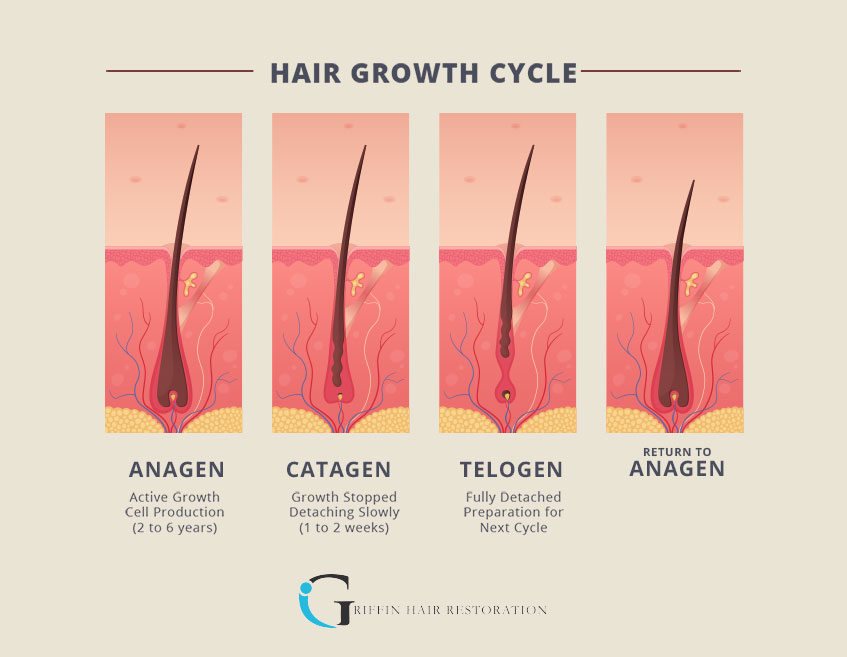Your Hair Growth Cycle
Written by Dr. Griffin
Hair plays a vital role in gender identity and self-expression. It is important to understand that human hair growth is affected by a cycle with three distinct phases:
The Anagen Phase
Hair growth begins with the Anagen Phase, also known as the growth phase. This period lasts between two to six years. Hairs in the active growth phase are called Anagen or sometimes terminal hairs. Approximately 85% of scalp hairs are in the Anagen phase at any one time. In pattern alopecia, the anagen phase gets progressively shorter leading to a progressively finer hair. Follicles do not go away. They just produce a finer hair.
The Catagen Phase
Known as the transitional phase, the Catagen Phase is the shortest of all the phases. During this phase, which lasts for a few weeks, the hair follicles begin to involute as they transition to the resting or telogen phase. There is a decline in hair cell division and the root shrinks to a third of its Anagen size. The follicle actually moves upward in the dermis and the hair begins to change to a club hair which will eventually shed as it enters telogen.
The Telogen Phase
Known as the resting phase, the Telogen Phase lasts for about 3-4 months. About 15% of hairs on the scalp are in this phase. Hairs are shed from their resting follicles at this time. About 25-100 hair shafts in the Telogen phase are shed each day. In some cases, for example, after delivery of a baby, more hairs may enter the telogen phase. In some cases, 30% of the follicles are in the telogen phase leading to a significant shedding known as Telogen Effluvium. These hairs will regrow and are not lost forever.

What about hair growth cycles in other body areas?
Hairs on different parts of the body have different hair cycles in which the Anagen or active growth phase is shorter than on the scalp. For this reason, hairs on other parts of the body do not attain the same length as scalp hair.
What can interfere with hair growth at the Anagen or growing phase?
Diseases, nutritional deficiencies, crash dieting, hormonal fluctuations, and even stress can cause the hair follicles to reduce their activity and lessen hair growth during the Anagen/growing phase. These also contribute to hair loss and may induce telogen effluvium.
What kind of nutritional deficiencies impair hair from growing during the cycle?
Nutritional deficiencies may contribute to hair loss. A healthy balanced diet with adequate protein and vitamins is important in maintaining bodily health, which includes hair health. Iron deficiency may contribute to hair loss especially in women. Biotin and omega 3 fatty acids are helpful supplements for maintaining hair health. Thyroid disease, mainly hypothyroidism, decreases hair growth.
How does age affect the hair growth cycle?
Hair growth and age correspond. The most abundant hair growth occurs between ages 15-30. The hair growth cycle begins to diminish its Anagen phase between ages 40- 50 leading to thinning in genetically predisposed individuals. Topical and oral medications can improve hair growth and maintain healthy looking hair. Also, as one ages, the hair shaft itself becomes weak due to thinning and to dryness caused by decreased activity of oil glands associated with the hair follicle. Good hair care and conditioning is important for maintaining the hair shaft and preventing breakage.
